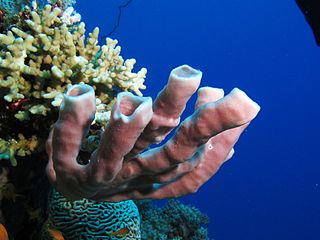
Phoriospongin A and B are Australian sea sponge isolates with nematocidal activity. They are depsipeptides and were obtained from Phoriospongia species and Callyspongia bilamellata. [1]

Phoriospongin A and B are Australian sea sponge isolates with nematocidal activity. They are depsipeptides and were obtained from Phoriospongia species and Callyspongia bilamellata. [1]
A depsipeptide is a peptide in which one or more of its amide, -C(O)NHR-, groups are replaced by the corresponding ester, -C(O)OR-. Many depsipeptides have both peptide and ester linkages. Elimination of the N–H group in a peptide structure results in a decrease of H-bonding capability, which is responsible for secondary structure and folding patterns of peptides, thus inducing structural deformation of the helix and β-sheet structures. Because of decreased resonance delocalization in esters relative to amides, depsipeptides have lower rotational barriers for cis-trans isomerization and therefore they have more flexible structures than their native analogs. They are mainly found in marine and microbial natural products.

Cryptophycins are a family of macrolide molecules that are potent cytotoxins and have been studied for potential antiproliferative properties useful in developing chemotherapy. They are members of the depsipeptide family.

Doriprismatica sedna is a species of colorful sea slug, a dorid nudibranch, a marine gastropod mollusk in the family Chromodorididae.

Callystatin A is a polyketide natural product from the leptomycin family of secondary metabolites. It was first isolated in 1997 from the marine sponge Callyspongia truncata which was collected from the Goto Islands in the Nagasaki Prefecture of Japan by the Kobayashi group. Since then its absolute configuration has been elucidated and callystatin A was discovered to have anti-fungal and anti-tumor activities with extreme potency against the human epidermoid carcinoma KB cells (IG50 = 10 pg/ml) and the mouse lymphocytic leukemia Ll210 cells (IG50 = 20 pg/ml).

Papuamides A and B are depsipeptides which appear to protect T cells from HIV. They were isolated from the sponge Theonella, and are part of a larger group of structurally similar depsipeptides—also isolated from sponges—including neamphamide A, callipeltin A, and mirabamides A-D.

Cadlina rumia is a species of sea slug or dorid nudibranch, a marine gastropod mollusk in the family Cadlinidae.

Callyspongia is a genus of demosponges in the family Callyspongiidae.

Callyspongia truncata is a species of marine sea sponge. Like all marine sponges, C. truncata is a member of phylum Porifera and is defined by its filter-feeding lifestyle and flagellated choanocytes, or collar cells, that allow for water movement and feeding. It is a species of demosponge and a member of Demospongiae, the largest class of sponges as well as the family Callyspongiidae. C. truncata is most well known for being the organism from which the polyketide Callystatin A was identified. Callystatin A is a polyketide natural product from the leptomycin family of antibiotics. It was first isolated in 1997 from this organism, which was collected from the Goto Islands in the Nagasaki Prefecture of Japan by the Kobayashi group. Recent studies have revealed numerous other bioactive compounds that have been found in this species.

Halicylindramides are a group of antifungal peptides. The first compounds of this type, designated halicylindramides A through E, were isolated from sea sponges of the genus Halichondria. More compounds in the family, designated F, G and H, were found in sponges of the genus Petrosia. Halicylindramide A has been synthesized by chemists.

Callipeltin A and B are depsipeptides isolated from marine invertebrates. Preliminary research shows that they may have antiviral activity.

Neamphamide A is an HIV-inhibitory isolate of the sea sponge Neamphius huxleyi.
Mirabamides are sea sponge isolates that inhibit HIV-1 fusion. Variants A to D are known from Siliquariaspongia mirabilis and E through H are derived from Stelletta clavosa. Mirabamides have a macrocyclic region closed through an ester bond between the C-terminus and a 𝛽-hydroxyl group, and terminated with a polyketide moiety or a more simple branched aliphatic acid.

Callyspongia crassa, commonly known as prickly tube-sponge, is a species of sponge found from the Red Sea to the Seychelles. Its wide flexible brown tube with exterior protuberances can appear as a single tube or as clusters of tubes and can reach up to 50 centimeters in size. Like many other sea sponges, it is primarily used for marine drugs as they have many bioactive components and properties. They also play an important role in marine reef and benthic communities, as they constantly filter water and act as habitats for smaller organisms. As sea sponges, they have the ability to reproduce both sexually and asexually.

Callyspongia siphonella, commonly known as colonial tube-sponge, is a species of sea sponge endemic to the Red Sea. Clusters of its pale lavender to pink long tubes reach up to 60 centimetres (24 in) in size. Callyspongia siphonella contains a bioactive compound, Sipholenol A., that has been studied for its anti-proliferative properties in human breast cancer; these properties provide promise in its potential for developing future compounds and thus contributes greatly to future cancer research.
Dysidea arenaria is a species of marine sponge (poriferan) found in the Pacific Ocean. It is a member of the order Dictyoceratida, one of two sponge orders that make up the keratose or "horny" sponges in which a mineral skeleton is absent and a skeleton of organic fibers is present instead.
Jorunna spongiosa is a species of sea slug, a dorid nudibranch, a shell-less marine gastropod mollusc in the family Discodorididae.

The microviridins are a class of serine protease inhibitors produced by various genera of cyanobacteria. Recent genome mining has shown that the biosynthetic gene cluster responsible for microviridin biosynthesis is much more prevalent, found in many species of Pseudomonadota and Bacteriodota.

Callyspongia plicifera, the azure vase sponge, is a species of sea sponge belonging to the family Callyspongiidae. It is native to the Bahamas where it is found at a depth of 31.5-44.2 m. It was first described in 1814 by Jean-Baptiste Lamarck.
Callyspongia elegans is a species of demosponge in the genus Callyspongia.